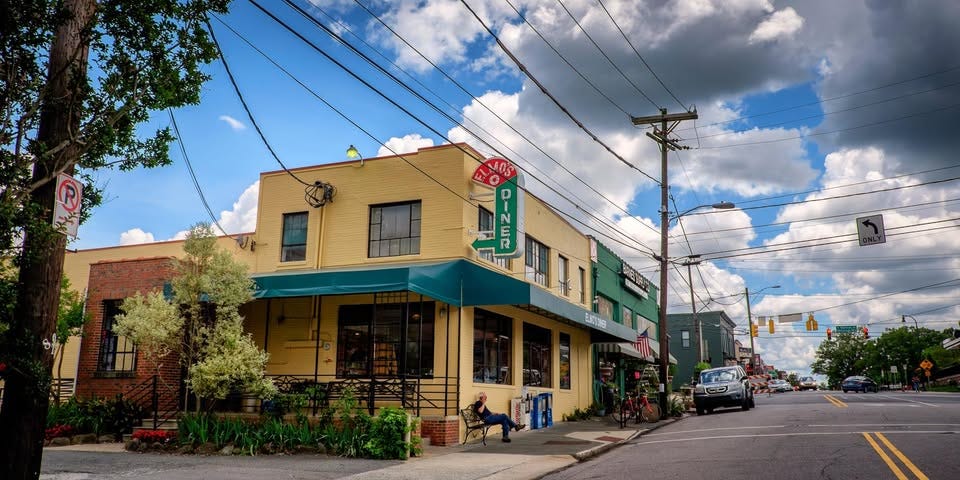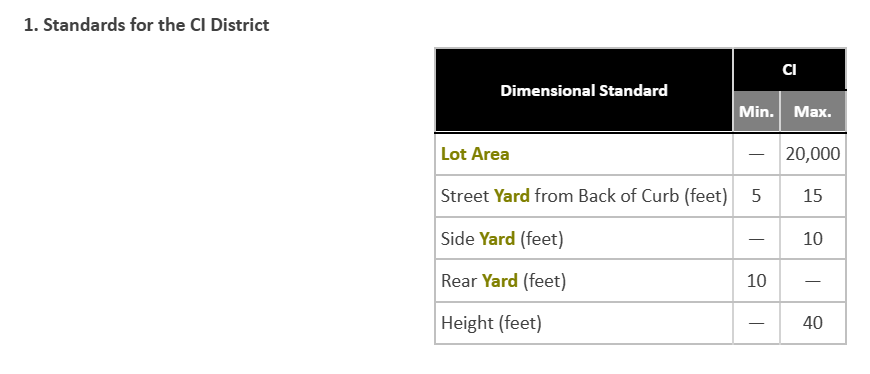Littler, Part 2
Why restaurantuer ownership opportunities are critical to a building a city's identity
Last week, I published a piece lamenting the closure of the Durham restaurant Littler. I articulated why restaurants matter and why the undersupply of small retail buildings hurts local business opportunities. This week, I discuss how to increase those building ownership opportunities, especially for those restauranteurs.

How Zoning Stifles Restaurants
Over the past 50 years, cities like Durham effectively ended the development of small neighborhood commercial buildings like Elmo’s (above). With the supply of such buildings artificially fixed, the owners of these properties quickly learned they owned a golden goose and rarely, if ever, sold (below).
Which created a problem.

This government-induced shortage of ownable retail space creates the “restauranteur squeeze” where, because of bad rules, the restaurant owner has no choice but to rent. That puts undue stress on our most ambitious restaurants and clearly causes a situation where fewer Durham restaurants are created—and more fail.
This can be averted simply by creating more ownership opportunities.
Durham has restaurateurs who are ready, willing, and able to own a building, and would be substantially better off, personally and professionally, if they could. But they can’t.
This stifling has many negative effects, which go far beyond increasing the number of quality restaurants and lowering undue stress on the proprietor. There are social costs, too.
Cities must stop obstructing such ownership because ownership is integral to citizen equity and growth. As they age, successful restaurateurs often become a city’s great civic philanthropists. Should these business leaders be relegated to a permanent class of renters, transformational wealth will decline, and philanthropic culture will happen less.
How to Foster More Restaurateur Building Ownership
In 2023, Durham passed an innovative CI (Commercial Infill Code) that addressed this problem by reopening small neighborhood commercial parcels to traditional retail development.
To understand these parcels, imagine the universal urban form of 0’ front and side setbacks, up to 3 stories, use-flexible with no on-site parking requirements. Basically, a Main Street building.

Think of any neighborhood commercial district (they exist all over the globe, in every culture) and imagine just one more building at the edge. At Angier and Drive, such a building might look like this:
A simple building, one lot over.
American planners have all but banned this incremental development practice (mostly without intending to, is my experience). Durham re-established it, with the Planning Department's blessing, I might add (we should give credit where credit is due).
The exact mechanisms of the reform are technical and beyond the scope of this essay. But, essentially, Durham has half a dozen small commercial zones (OI, CG, IL, and CN), all of which consistently did not work. This was primarily because of parking requirements but also because of an overthought and an incongruent use table. The reform allowed all of these zones to use the simple, practical, and urban CI standard as long as they were less than 20,000 SF, essentially half an acre.
Critically, these are small—very small—parcels.
That half-acre maximum lot size matters and was specifically identified to foster localism (i.e., resist corporatism) in these walkable neighborhood districts. Because you know who wants nothing to do with a 20,000sf parcel? Dollar General.

By limiting these financialized opportunities through the implementation of a maximum lot size, probably one of the first in the country, land use policy was tilted back in favor of the locals (FWIW, traditional zoning still heavily favors large national players, but in this narrow case in Durham, it does not).
There hasn’t been much happening with the CI code yet, as the code is still complex, and few willing sellers have materialized. However, I do know of a few projects pursuing ambitious things subject to this reform. Better things are sure to come.
Policy is Downstream of Culture. Development is Downstream of Policy.
“Retailers are the Ambassadors to your city.” - Ryan Hurley
It’s a policymaker’s duty to support retail talent because, as Vert and Vouge retailer Ryan Hurley said, “Retailers are the Ambassadors to your city.”
When you go to a place, be it Durham, Dallas, or Dubai, the experiences you remember are the ones brought to you by the city’s restaurants and retailers. You may see a Duke basketball game or a show at DPAC, but the things that make Durham Durham are the small spaces that serve food, drinks, entertainment, and other highly-curated, creative experiences.
Policymakers can identify and accelerate already this existing cultural change. Restaurants in Durham are worthy of such change and support. Some of these changes are technical, and some are more spiritual, requiring leadership and new calls for respect.
On the technical side, Much reform is needed here. And culture change. Small business owners are still burdened with obtuse stormwater and sprinkler requirements that can trigger hundreds of thousands of dollars of engineering solutions for coffee shops that cost a small fraction of that. Stormwater rules are written for huge entities and never scaled down for smaller ones (and it’s a political third rail to even talk about the issue). District stormwater treatment is also worthy of exploration because each small restaurant on an urban commercial corridor cannot afford its own storm pond but might be able to pay into innovative, larger district solutions.
The same scalability problems exist for sprinklers as well.

Further, more retail districts can be zoned in response to demand. As these spaces are allowed to be infinitely small, more opportunities arise. Pop-up stores are what I call “Phase 0” development: non-permanent structures that generally stay clear of building inspection and Durham’s stifling development reviews.
If every vendor at the Farmer’s Market had to go through an 18-month entitlement process, then we’d have fewer vendors at the Farmer’s Market, and the Farmer’s Market would be worse.
Those onerous reviews raise the threshold at which a permanent structure is viable. Lots of trauma happens in the space under that threshold, with retailers desperate for small spaces that they can own and remodel without going bankrupt.
Because of these thresholds, Durham has too few small spaces available for start-up retailers. I have had friends brought to tears by the lack of small spaces. As far as I can tell, there is near infinite demand for affordable small retail space (less than 1000sf), while demand tapers off as spaces exceed 2000sf.
Task forces working with retailers, developers, and restaurateurs should explore how to create more of these micro-spaces and how to maximize ownership of all of them. Such a goal would mainly require code reform and process predictability.
But it also requires a culture change.
In the spirit of placemaking, the culture requires a paradigm shift towards respecting local risk-takers and celebrating them for their ambition, vision, and service to the city. Too often, we are attacking these small businesspeople rather than appreciating them, and that does have a sclerotic effect on the city’s heartbeat. The city and its media personalities can collectively work to ensure that the culture of great restaurateuring is protected, honored, and enhanced.
The Next Littler
Any such reforms will be too late for Littler, but we should use this opportunity to think of the next Littler. There are kids in high school right now who can (and will) provide the next great restaurant in Durham. Some will do it, even if they don’t own their building. Many more will if they do.
How can a city support such young people? It takes some encouragement and respect, but mostly, it requires getting out of the way.
Restaurateurs and developers will build new restaurant spaces when they are allowed to. Thus, it is critical that we ensure that they are allowed to.
Kudos to Durham for starting that process with its recent CI code reforms and to its citizens for supporting incremental and experimental food developments such as the Durham Farmer’s Market, Durham Food Hall, The Green Flea Market, and The Can Opener.
Thanks to Gray Brooks for years of greatness at Littler and hope for continued success at other restaurants, with the added hope that he will start another in the not-too-distant future.
Follow me and join the conversation on: X LinkedIn Instagram Bluesky Substack






In part 2 of my commentary on the closure of Littler, I itemize what local policymakers can do to ensure future storefront businesses survive and thrive.
Thanks, Aaron. This is all interesting. The background info helps me better understand why things are the way they are here. We Durhamites are used to great restaurants coming and going - nothing lasts forever. But I wish this were true only when the restaurant owner chooses to close, and not because they can't afford to stay open.
I love Ryan's quote, and he and Nadira are wonderful Durham ambassadors. I think local restaurants and bars play an even more important role in attracting and welcoming newcomers, and creating community. It's one of our calling cards, and we can't afford to lose it.